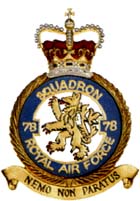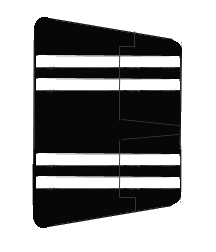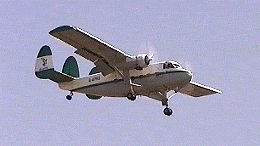78 Squadron Royal Air Force
Squadron motto -
|
|
78 Squadron was formed on November 1st 1916 at Harrietsham, Kent as a Home Defence Squadron. It was equipped with the B.E 2c with which it performed anti-Zeppelin patrols with little success. The HQ for the squadron at this time was Hove.
In September 1917 it moved to Suttons Farm, later to become Hornchurch, to be re-equipped with Sopwith 1-1/2 Strutter's. The Strutter saw tasked with protecting the area to the East of London from German Gotha Bombers but this too has little success. Later Strutters were augmented by Sopwith Camels. At the end of the War the Squadron took a few Sopwith Snipe's only to be disbanded on December 31st 1919.
In the reamament run up to World War Two 78 Squadron were reformed from 'B' flight of 10 Squadron at Boscome Down flying Heyford Bombers Attached to 4 Group Bomber Command. A move to Dishforth also brought a re-equipment with Armstrong Whitworth Whitleys. Although re-equipment was complete at the outbreak of the War 78 were designated as a training unit for aircrew from the Group Pool units. The Squadron was awarded its badge in November 1939 by King George VI. To reflect the aircraft at the time the badge shows a Heraldic Tiger with two tails. This mimicked the Whitley with its two rudders and Tiger engines.
On July 19th 1940 the first operational training unit was formed enabling the squadron to take part in night operations over Germany.
The Squadron was involved in the first Airborne Allied operation of World War Two in February 1941 for Operation Colossus. Diversionary Bombing was carried out during the operation when British Paras transported in the Whitleys destroyed a large aqueduct at Tragino in southern Italy.
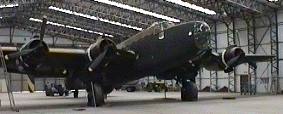
Handley Page Halifax BIII
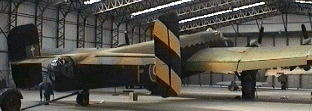
Elvington Ait Museum. York
In March 1942 the squadron received the Handley Page Halifax which it operated until the end of the war. It took part in many famous operations from 1942 when it received its mainstay Halifax's. Notable operations include 1000 bomber raids on Cologne on 30/31 May 1942, the attack on Peenemunde where German Rocket research was taking place over 17/18th August 1943. The Halifax's also directly supported the Normandy Landings. The day to day operations throughout 1944 included many sorties against V1 Flying Bomb launch sites in France
|
|
To enable the squadrons of 4 Group to form up in the air they began to wear distinctive markings on their tails. This lasted for about a year during 1944-45. This shows the stripes worn by the Halifax BIII's of 78 Squadron circa March 1945. They were usually in applied chalk and needed to be redrawn frequently! |
The squadron was transferred to Transport command in May of 1945 swapping its Halifax VI aircraft for Dakota's and moving from its long time base of Breighton to the Mediterranean and far east theatre. Dakotas were eventually replaced with Valettas until the Squadron was disbanded on September 30th 1954.
|
Reformation came on 24 April 1956 with Pioneers in Aden as an army support Unit. Pioneers were replaced with Twin Pioneers in 1958 which it operated until 1967. The squadron operated Wessex Helicopters from 1965 to 1967 in Aden with half the Squadron moving to Sharjah in Oct 1967 in a move to Sharjah. The Squadron split again in Dec 1967 when a detatchment was sent to Bahrein to form a Searh & Rescue unit. Disbandenment again came on 1st December 1971. |
|
|
|
|
Twin Pioneer operated by Air Atlantic |
|
The Squadron was reformed again in the 1980's. It is now operates army support in the Falkland Islands and is split into two flights - A Flight with the Chinook HC.1(HC.2) and B Flight with Sea King HAR.3 . It was formed from 1310 Flt, which was the Chinook unit based at Kellys Garden, and 1564 Flt which was the Sea King unit based at Navy Point.
